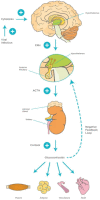COVID-19 and Neurological Impairment: Hypothalamic Circuits and Beyond
- PMID: 33802995
- PMCID: PMC8002703
- DOI: 10.3390/v13030498
COVID-19 and Neurological Impairment: Hypothalamic Circuits and Beyond
Abstract
In December 2019, a novel coronavirus known as severe acute respiratory syndrome coronavirus 2 (SARS-CoV-2) emerged in Wuhan, the capital of Hubei, China. The virus infection, coronavirus disease 2019 (COVID-19), represents a global concern, as almost all countries around the world are affected. Clinical reports have confirmed several neurological manifestations in COVID-19 patients such as headaches, vomiting, and nausea, indicating the involvement of the central nervous system (CNS) and peripheral nervous system (PNS). Neuroinvasion of coronaviruses is not a new phenomenon, as it has been demonstrated by previous autopsies of severe acute respiratory syndrome coronavirus (SARS-CoV) patients who experienced similar neurologic symptoms. The hypothalamus is a complex structure that is composed of many nuclei and diverse neuronal cell groups. It is characterized by intricate intrahypothalamic circuits that orchestrate a finely tuned communication within the CNS and with the PNS. Hypothalamic circuits are critical for maintaining homeostatic challenges including immune responses to viral infections. The present article reviews the possible routes and mechanisms of neuroinvasion of SARS-CoV-2, with a specific focus on the role of the hypothalamic circuits in mediating the neurological symptoms noted during COVID-19 infection.
Keywords: COVID-19; SARS-CoV-2; hypothalamic circuits; hypothalamic–pituitary–adrenocortical axis; neurological manifestations; olfactory bulb; respiratory centers; viral infection.
Conflict of interest statement
The authors declare no conflict of interest.
Figures



References
-
- World Health Organization . Coronavirus Disease (COVID-19) Pandemic Reports. World Health Organization; Geneva, Switzerland: 2020.
Publication types
MeSH terms
LinkOut - more resources
Full Text Sources
Other Literature Sources
Medical
Miscellaneous

